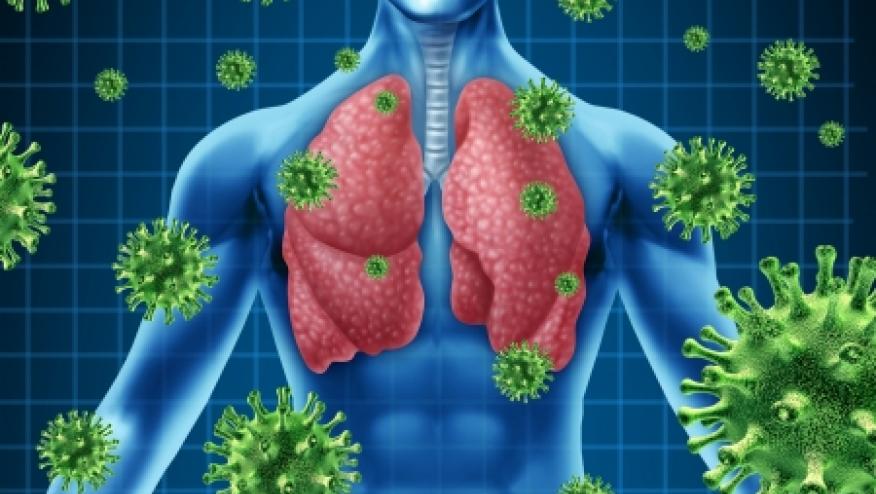Past Infection, Lung Disease Raise Risk for Myopathy Save

Infections and noninfectious pulmonary disease were associated with an increased risk for idiopathic inflammatory myopathies (IIM), a Swedish study found.
Among 957 cases of IIM, 13% had previous infections reported to the National Patient Register, compared with 9% of 9,476 controls, which was a 50% higher risk (OR 1.5, 95% CI 1.2-1.9), said John Svensson, a PhD student, and colleagues from the Karolinska Institute in Stockholm, Sweden.
In addition, respiratory tract diseases were seen in 10% of cases versus 4% of controls, which doubled the risk (OR 2.3, 95% CI 1.8-3), as shown in the study, published online in Annals of the Rheumatic Diseases.
The IIMs are a group of autoimmune diseases characterized by inflammation and weakness of the muscles, and include polymyositis, dermatomyositis, and inclusion body myositis. All are thought to result from interactions between genetic and environmental factors. The strongest genetic factor that has been identified is the HLA-DRB1*0301 gene, but little is known about potentially relevant environmental exposures.
"Infections could trigger autoimmunity through multiple mechanisms including molecular mimicry and epitope spreading and have been implicated in the development of other rheumatic diseases such as rheumatoid arthritis," the researchers wrote.
Case reports have suggested a link between infections and IIM, but there have not been any population-based data on this.
The lung is of special interest in the etiology of IIM, because many patients have lung involvement at the time of diagnosis such as fibrosis or infiltrates, and the mucosal tissue could be the site of the initiation of autoimmunity following exposure to infectious agents. In addition, smoking may play a role in autoimmune events in the lung such as autoantibody production, as has been shown in rheumatoid arthritis.
Therefore, to explore the potential for infection and lung disease in the development of IIM, Svensson and colleagues conducted a case-control study of newly diagnosed individuals with IIM and matched controls from national registries. A latency period of 1 year between the infection or pulmonary disease and the IIM diagnosis was required to minimize the possibility of reverse causality.
"Investigating exposures more than 1 year before the IIM diagnosis enabled us to examine the potential role of exposure long before disease onset, which could have a greater influence on disease development rather than exposures occurring in close proximity to disease onset," the team explained.
Among cases, 57% were women, with a mean age of 59. The subtype of IIM was dermatomyositis in 31% of the cases, and "other" in the remainder.
Among cases, the mean time between the most recent infection and IIM diagnosis was 3.4 years; the mean time since diagnosis of respiratory tract disease such as asthma or chronic obstructive pulmonary disease was 3 years. A similar pattern was seen for controls.
For specific types of infections, the risk of IIM was increased both for respiratory tract infections (OR 1.6, 95% CI 1.1-2.3) and gastrointestinal tract infections (OR 1.9, 95% CI 1.1-3.5). Skin infections were not associated with risk (OR 1.2, 95% CI 0.8-2).
For noninfectious respiratory tract disease, the risk of IIM was increased for both upper (OR 1.9, 95% CI 1.3-2.7) and lower (OR 2.4, 95% CI 1.8-3) tract disease.
In a sensitivity analysis that adjusted for greater previous healthcare consumption as a proxy for worse overall health among IIM cases, the associations were attenuated but still significant for infections (OR 1.3, 95% CI 1.1-1.7) and for noninfectious respiratory disease (OR 2.2, 95% CI 1.7-2.8).
In an additional analysis that excluded patients with other connective tissue diseases, IIM-associated malignancies, and IIM-related lung disease, the association remained significant for infections (OR 1.4, 95% CI 1.1-1.9) and respiratory tract disease (OR 2.2, 95% CI 1.6-3.1).
The authors noted that their findings do not support the concept of the hygiene hypothesis, in which early exposure to infectious agents is thought to be protective against autoimmunity, but rather implicate respiratory and gastrointestinal infections in disease etiology: "Gastrointestinal infections could change the gut microbiota, causing autoimmunity by affecting immunoregulatory mechanisms."
Infections and chronic noninfectious respiratory diseases such as asthma also may contribute to autoimmunity through local inflammatory effects, "or a general activation of the immune system could be involved in disease pathogenesis, possibly through priming of self-reactive lymphocytes and autoantibody production," the team wrote.
Regarding study limitations, the researchers pointed to the possibility of residual confounding.
The study was funded by the Swedish Society of Medicine, the Swedish Research Council, the Swedish Rheumatism Association, the King Gustaf V 80 Year Foundation, the Karolinska Institute, and the Stockholm County Council.
One co-author reported a financial relationship with Bristol-Myers Squibb and AstraZeneca.










If you are a health practitioner, you may Login/Register to comment.
Due to the nature of these comment forums, only health practitioners are allowed to comment at this time.